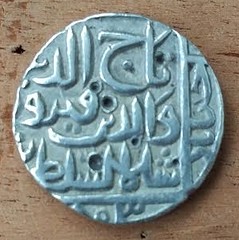
PREV ARTICLE
NEXT ARTICLE
FULL ISSUE
PREV FULL ISSUE
SHROFF MARKSRegarding David Pickup's question about holes found in Indian silver coins, These are shroff marks from strikes used to check purity of the silver in the coin. There occur frequently on coins of this era and it is difficult to find one without any. Kavan referenced this entry from the Fitzwilliam Museum's Numismatic Glossary: chop-marks Punch marks stamped on to foreign silver coins in China as a sign that they had been tested and approved for a transaction. In India these are known as 'shroff-marks'. To read the complete Glossary see: Ken Spindler of San Diego writes: I believe those are "shroff marks," i.e., hammered test punches or sites of tiny silver boring (enabling stealing tiny samples) administered by shroffs - employees of merchants or bankers who were skilled at determining silver purity by examining the color of the silver below the surface of the coin - and whether silver on the surface wasn't merely a veneer on a cast counterfeit of nonprecious metal. Such marks are extremely common on worn "dump" style (crude, thick, unround planchets) silver coinage that circulated in India for hundreds of years. The marks are not always round. They are very often found on the edges of dump silver coins, too. Test cuts on coin edges seem to have served the same purpose(s). I believe I read that such Indian silver testers were eventually brought into China to teach the Chinese to test foreign silver coinage accepted in commerce there as bullion, apparently beginning in the late 17th century. The Chinese versions are "chopmarks," which were larger countermarks for the same purpose, hand-hammered with a punch, much more elaborate and distinctive - so a merchant or banker might know by his mark, which was possibly always placed on the same location of a coin, whether he'd previously tested a given piece. Foreign silver in China often ended up being melted into assayed "sycee" ingots to pay taxes. I carry a moderately worn 17th century Mughal Indian rupee bearing numerous shroff marks in my pocket change wallet in hopes it's spotted and sparks a numismatic conversation or spontaneous history discussion when out shopping. (Never happens.) Shailendra Bhandare writes (in a note to David Pickup): These are testing marks applied as the coin circulated, to attest whether it was fully of silver, or a forgery made by plating a copper core with silver. This was normal practice in some areas of India during this period. More number of marks will generally be regarded as a downgrading of the coin's condition. The money-changers thought that too - as we have evidence that coins with more test marks were subject to more discount! Thanks. We have very little on shroff marks in the E-Sylum archive; they're mentioned only as an alternate term for
chopmark. But these are a little different - holes left when material was taken away for testing, rather than leaving a symbol signifying who had
done a test and deemed the coin good. Interesting. -Editor
Ken adds: Fake Chinese chopmarks do exist, to enhance the value for chopmarked coin collectors of an otherwise boring coin which never saw China. A famous coin dealer in the US is known to have done that - Hans Schulman, who bought two genuine assay chop dies used by a Thai silversmith, one the silversmith's name in Thai, and the other, the same name in Chinese, and went crazy for a few days chopping hundreds of coins himself with the same punches. Amongst other things, I collect Indian coins "by type" back to about 1850, and have many dozens of different varieties of "dump" rupees and partial rupees, almost all of which bear multiple tiny shroff marks, and maybe almost 100% of those include multiple shroff test marks on the edges. Because of their ubiquity, I ignore their presence and would not reject a coin because of them unless they really wreck the design elements (usually just ornate Urdu calligraphy), bend the coin, and/or harbor ugly corrosion. David Pickup writes: Thank you to the contributors! To read the earlier E-Sylum article, see: Wayne Homren, Editor The Numismatic Bibliomania Society is a non-profit organization promoting numismatic literature. See our web site at coinbooks.org. To submit items for publication in The E-Sylum, write to the Editor at this address: whomren@gmail.com To subscribe go to: https://my.binhost.com/lists/listinfo/esylum All Rights Reserved. NBS Home Page Contact the NBS webmaster 
|
